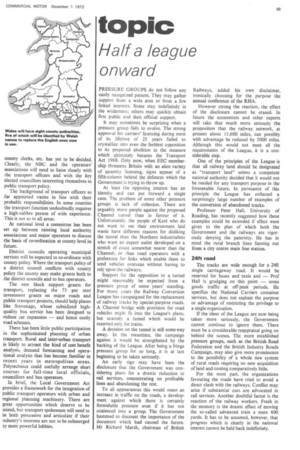topic
Page 61

If you've noticed an error in this article please click here to report it so we can fix it.
Haifa league onward
PRESSURE GROUPS do not follow any easily recognized pattern. They may gather support from a wide area or from a few linked interests. Some stay indefinitely in the wilderness; others may quickly obtain first public and then official support.
It may sometimes be surprising when a pressure group fails to evolve. The strong approval for carriers' licensing during most of its lifetime of 25 years failed to crystallize into even the feeblest opposition to its proposed abolition in the measure which ultimately became the Transport Act 1968. Only now, when EEC membership threatens Britain with an alien variety of quantity licensing, signs appear of a fifth-column behind the defences which the Government is trying to throw up.
At least the opposing interest has an identity and can put forward a single case. The problem of some other pressure groups is lack of cohesion. There are arguably more people against the proposed Channel tunnel than in favour of it. Unfortunately, the people of Kent who do not want to see their environment laid waste have different reasons for disliking the tunnel than the Northern industrialists who want an export outlet developed on a stretch of coast somewhat nearer than the Channel; or than road operators with a preference for links which enable them to send vehicles overseas without having to rely upon the railways.
Support for the opposition to a tunnel might reasonably be expected from a pressure group of some years' standing. For many years the Railway Conversion League has campaigned for the replacement of railway tracks by special-purpose roads. A Channel bridge with provision for road vehicles might fit into the League's plans, but scarcely a tunnel which would be reserved only for trains.
A decision on the tunnel is still some way away. In the meantime, the campaign against it would be strengthened by the backing of the League. After being a fringe pressure group for so long, it is at last beginning to be taken seriously.
An early sign may have been the disclosure that the Government was considering plans for a drastic reduction in rail services, concentrating on profitable lines and abandoning the rest.
To all appearances this would mean an increase in traffic on the roads, a development against which there is certainly formidable pressure even if it has not coalesced into a group. The Government hastened to discount the importance of the document which had caused the furore. Mr Richard Marsh, chairman of British Railways, added his own disclaimer, ironically choosing for the purpose the annual conference of the RHA.
However strong the reaction, the effect of the disclosure cannot be erased. In future the economists and other experts will take that much more seriously the proposition that the railway network, at present about 11,600 miles, can possibly with advantage be reduced by 5000 miles. Although this would not meet all the requirements of the League, it is a considerable step.
One of the principles of the League is that all railway land should be designated as "transport land" unless a competent national authority decided that it would not be needed for any transport purpose in the foreseeable future. In pursuance of this principle the League has collected a surprisingly large number of examples of the conversion of abandoned tracks.
Professor Peter Hall, University of Reading, has recently suggested how these examples could be extended if effect were given to the plan of which both the Government and the railways are vigorously denying the paternity. He has in mind the rural branch lines fanning out from a city centre main line station.
24ft road The tracks are wide enough for a 2411 single carriageway road. It would be reserved for buses and taxis and — Prof Hall is grudging on this point — some goods traffic at off-peak periods. He specifies the National Carriers container services, but does not explain the purpose or advantage of restricting the privilege to a single organization.
If the ideas of the League are now being taken more seriously, the Government cannot continue to ignore them. There must be a considerable reappraisal going on behind the scenes. The more established pressure groups, such as the British Road Federation and the British Industry Roads Campaign, may also give more prominence to the possibility of a whole new system of rural roads requiring no new acquisition of land and costing comparatively little.
For the most part, the organizations favouring the roads have tried to avoid a direct clash with the railways. Conflict may arise if substantial cuts are advocated in rail services. Another doubtful factor is the reaction of the railway workers. Fresh in the memory is the drastic effect of moving the so-called advanced train a mere 400 yards. It has to be assumed, however, that progress which is clearly in the national interest cannot be held back indefinitely.
































































































































